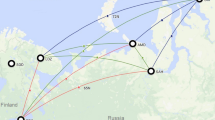Abstract
The network for monitoring the high-latitude ionosphere by the method of oblique ionospheric sounding deployed in the Russian Arctic region is considered. The study describes the main results of operational data processing for studying the high-latitude ionosphere and determining the conditions for the optimum operation of radio communication systems and over-the-horizon radars in this region. The study demonstrates the potential of the network as a tool for the remote diagnostics of parameters of small-scale artificial ionospheric irregularities induced by powerful HF radio waves in the mid-latitude ionospheric F-region.






Similar content being viewed by others
REFERENCES
N. F. Blagoveshchenskaya, Geophysical Effects of Modifications in the Near-Earth Space (Gidrometeoizdat, St. Petersburg, 2001) [in Russian].
D. V. Blagoveshchensky, O. A. Maltseva, M. M. Anishin, and D. D. Rogov, “Sporadic E S Layers at High Latitudes during a Magnetic Storm of March 17, 2015 According to the Vertical and Oblique Ionospheric Sounding Data,” Izv. Vuzov. Radiofizika, No. 6, 60 (2017) [Radiophys. Quantum El., No. 6, 60 (2017)].
B. E. Bryunelli and A. A. Namgaladze, Ionospheric Physics (Nauka, Moscow, 1988) [in Russian].
V. A. Ivanov, V. I. Kurkin, V. E. Nosov, V. P. Uryadov, and V. V. Shumaev, “Chirp Ionosonde and Its Application in the Ionospheric Research,” Izv. Vuzov. Radiofizika, No. 11, 46 (2003) [Radiophys. Quantum El., No. 11, 46 (2003)].
A. I. Kalinin and E. L. Cherenkova, Propagation of Radio Waves and Operation of Radio Lines (Svyaz’, Moscow, 1971) [in Russian].
D. D. Rogov, “Organization of Operation of the AARI High-latitude Network for Oblique Ionospheric Sounding. Algorithms for Automatic Processing and Presentation of Data,” in Proceedings of the Conference of Young Specialists in Hydrometeorology and Environmental Monitoring, Obninsk, June 4–6, 2013.
D. D. Rogov, P. E. Baryshev, and V. M. Vystavnoi, “Monitoring the Ionosphere and HF Radio System Operation Conditions in the Arctic Region of the Russian Federation,” in Proceedings of the 16th Conference of Young Scientists “Interaction of Fields and Radiation with Matter” (Irkutsk, 2019) [in Russian].
D. D. Rogov and V. M. Vystavnoi, “Studying the Parameters of High-frequency Radio Wave Propagation at the Network of Oblique Ionospheric Sounding Routes in the Arctic Region of the Russian Federation,” Mir Izmerenii, No. 7 (2014) [in Russian].
D. D. Rogov, “Study of the Sporadic Es Layers Occurrence Probability Based on the Ionospheric Oblique Sounding Network Data in the Russian Arctic Region,” in Conference “Radiation and Scattering of Electromagnetic Waves (RSEMW) 2019.”
D. D. Rogov, N. F. Blagoveshchenskaya, and T. K. Yeoman, “Features of Artificial Ionospheric Irregularities Induced by Powerful HF Radio Waves from Bi-static Scatter Measurements,” in Conference “Radiation and Scattering of Electromagnetic Waves (RSEMW) 2019.”
Author information
Authors and Affiliations
Corresponding author
Additional information
Translated from Meteorologiya i Gidrologiya, 2021, No. 4, pp. 5-13. https://doi.org/10.52002/0130-2906-2021-4-5-13.
About this article
Cite this article
Rogov, D.D., Vystavnoi, V.M., Blagoveshchenskaya, N.F. et al. Russian High-latitude Network of Oblique Ionospheric Sounding. Russ. Meteorol. Hydrol. 46, 217–224 (2021). https://doi.org/10.3103/S1068373921040014
Received:
Published:
Issue Date:
DOI: https://doi.org/10.3103/S1068373921040014



